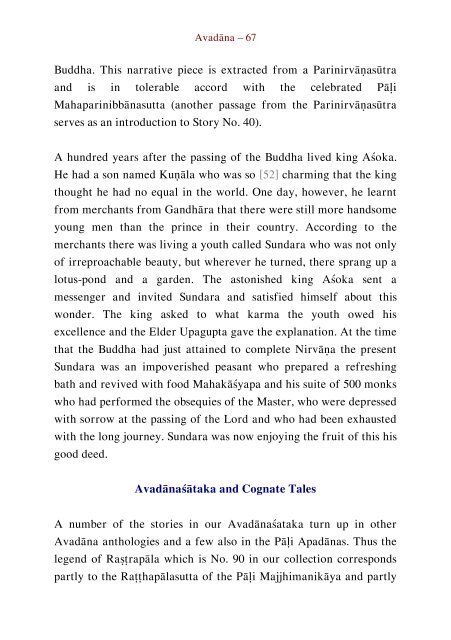Literary History of Sanskrit Buddhism
A study by J. K. Nariman of Sanskrit Buddhism from the Early Buddhist Tradition up to the Mahayana texts proper.
A study by J. K. Nariman of Sanskrit Buddhism from the Early Buddhist Tradition up to the Mahayana texts proper.
You also want an ePaper? Increase the reach of your titles
YUMPU automatically turns print PDFs into web optimized ePapers that Google loves.
Avadāna – 67<br />
Buddha. This narrative piece is extracted from a Parinirvāṇasūtra<br />
and is in tolerable accord with the celebrated Pāḷi<br />
Mahaparinibbānasutta (another passage from the Parinirvāṇasūtra<br />
serves as an introduction to Story No. 40).<br />
A hundred years after the passing <strong>of</strong> the Buddha lived king Aśoka.<br />
He had a son named Kuṇāla who was so [52] charming that the king<br />
thought he had no equal in the world. One day, however, he learnt<br />
from merchants from Gandhāra that there were still more handsome<br />
young men than the prince in their country. According to the<br />
merchants there was living a youth called Sundara who was not only<br />
<strong>of</strong> irreproachable beauty, but wherever he turned, there sprang up a<br />
lotus-pond and a garden. The astonished king Aśoka sent a<br />
messenger and invited Sundara and satisfied himself about this<br />
wonder. The king asked to what karma the youth owed his<br />
excellence and the Elder Upagupta gave the explanation. At the time<br />
that the Buddha had just attained to complete Nirvāṇa the present<br />
Sundara was an impoverished peasant who prepared a refreshing<br />
bath and revived with food Mahakāśyapa and his suite <strong>of</strong> 500 monks<br />
who had performed the obsequies <strong>of</strong> the Master, who were depressed<br />
with sorrow at the passing <strong>of</strong> the Lord and who had been exhausted<br />
with the long journey. Sundara was now enjoying the fruit <strong>of</strong> this his<br />
good deed.<br />
Avadānaśātaka and Cognate Tales<br />
A number <strong>of</strong> the stories in our Avadānaśataka turn up in other<br />
Avadāna anthologies and a few also in the Pāḷi Apadānas. Thus the<br />
legend <strong>of</strong> Raṣṭrapāla which is No. 90 in our collection corresponds<br />
partly to the Raṭṭhapālasutta <strong>of</strong> the Pāḷi Majjhimanikāya and partly


















